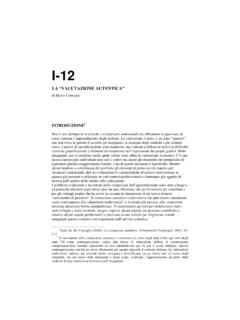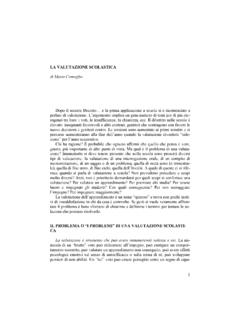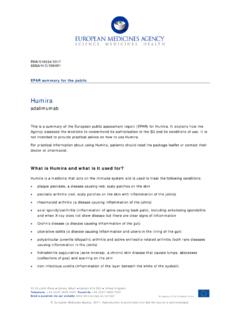Transcription of Handbook for monitoring and evaluation of child …
1 Rural eMPlOYMent Guida nce M at er i a l # 2. Handbook for monitoring and evaluation of child labour in agriculture Measuring the impacts of agricultural and food security programmes on child labour in family-based agriculture Guida nce m at er i a l # 2. Handbook for monitoring and evaluation of child labour in agriculture Measuring the impacts of agricultural and food security programmes on child labour in family-based agriculture Food and Agriculture Organization of the United Nations, Rome 2015. The designations employed and the presentation of material in this information product do not imply the expression of any opinion whatsoever on the part of the Food and Agriculture Organization of the United Nations (FAO) concerning the legal or development status of any country, territory, city or area or of its authorities, or concerning the delimitation of its frontiers or boundaries.
2 The mention of specific companies or products of manufacturers, whether or not these have been patented, does not imply that these have been endorsed or recommended by FAO in preference to others of a similar nature that are not mentioned. The views expressed in this information product are those of the author(s) and do not necessarily reflect the views or policies of FAO. ISBN 978-92-5-108779-4. FAO, 2015. FAO encourages the use, reproduction and dissemination of material in this information product.
3 Except where otherwise indicated, material may be copied, downloaded and printed for private study, research and teaching purposes, or for use in non-commercial products or services, provided that appropriate acknowledgement of FAO. as the source and copyright holder is given and that FAO's endorsement of users' views, products or services is not implied in any way. All requests for translation and adaptation rights, and for resale and other commercial use rights should be made via or addressed to FAO information products are available on the FAO website ( ) and can be purchased through Cover photo: FAO.
4 Handbook for monitoring and evaluation of child labour in agriculture Table of contents Abbreviations and acronyms ..x 1. Users ..1. Why should agricultural programmes include the child labour topic in their M&E system?.. 4. How do agricultural and food security programmes influence child labour?..5. Good practices to address child PART 1: child LABOUR IN FAMILY-BASED 9. 1. child labour definitions, causes and Definitions and international 11. Causes of child Consequences of child 14. 2. child labour in family-based 15.
5 Definition of family-based agriculture .. 15. Prevalence of child labour .. 15. Challenges in addressing child labour in family-based 16. 3. Children's involvement in the agricultural Crop 17. 17. Fisheries and PART 2: M&E OF PROGRAMME IMPACTS ON child 21. 1. Criteria for assessing child labour ..23. Must-know criteria ..23. Must-know background 24. table of contents iii 2. Integrating the child labour topic in the programme Programme 3. Steps for assessing programme impacts on child Preparation of the Data Data 41.
6 PART 3: 45. How to use the 47. Programme staff TOOL 1: Programme impact TOOL 2: Extended programme impact TOOL 3: Stakeholder map ..54. TOOL 4: Spider TOOL 5: Interview with programme TOOL 6: Interview with 61. TOOL 7: Guidelines for the integration of a child labour module into a household TOOL 8: Daily schedule / daily TOOL 9: Expert FOCUS GROUP 66. TOOL 10: Venn TOOL 11: Village social TOOL 12: Observation 71. TOOL 13: Problem and solution TOOL 14: Influence 74. TOOL 15: Impact 76. TOOL 16: School attendance TOOLKIT: TEMPLATE 1 - Interview with programme TEMPLATE 2 Interview with a TEMPLATE 3 Expert TEMPLATE 4 Observation TEMPLATE 5 Influence TEMPLATE 6 School attendance 91.
7 Iv Handbook for monitoring and evaluation of child labour in agriculture APPENDIX APPENDIX child LABOUR IN CROP child LABOUR IN child LABOUR IN FISHERIES AND child LABOUR IN 101. List of tables TABLE 1: Structure of the TABLE 2: Intended positive impacts of agricultural programmes on child TABLE 3: Good practices for addressing child TABLE 4: Supply and demand factors of child TABLE 5: Necessary steps for assessing programme impacts on child TABLE 6: Gathering information using tools in the TABLE 7: Most vulnerable TABLE 8: Analysis categories for processing TABLE 9: Analysis table for identifying child TABLE 10: Analysis table for identifying the programme impacts.
8 41. TABLE 11: Structure of the TABLE 12: Description and potential of the 48. TABLE 13: Guiding questions for identifying programme TABLE 14: Programme impact TABLE 15: Guiding questions for identifying programme TABLE 16: Cooperation TABLE 17: Do's and don'ts for TABLE 18: Do's and don'ts for interviewing TABLE 18: Do's and don'ts for interviewing TABLE 19: Do's and don'ts for focus group TABLE 20: Rating the influence of agricultural TABLE 21: Templates TABLE 22: Examples of potential positive and negative impacts of agricultural programmes on child TABLE 23.
9 Tasks, hazards and health risks of children in crop TABLE 24: Tasks, hazards and health risks of children in TABLE 25: Tasks, hazards and health risks of children in fisheries and TABLE 26: Tasks, hazards and health risks of children in table of contents v List of figures FIGURE 1: Structure of the FIGURE 2: Typical impacts of agricultural FIGURE 3: Vicious cycle of poverty ..14. FIGURE 4: Programme FIGURE 5: Extended programme impact FIGURE 6: Stakeholder FIGURE 7: Spider diagram for child labour FIGURE 8: Daily clock.
10 64. FIGURE 9: Venn FIGURE 10: Problem vi Handbook for monitoring and evaluation of child labour in agriculture Foreword Many children around the world work on the farm, help out on the fishing boat, herd the cattle, or reap fruits or collect burning wood in forests. For poor families, such activities by children are important to their livelihoods. The children acquire agricultural and life skills which can bear them fruits in their future lives. For about 100 million girls and boys, however, working in agriculture is not as beneficial.















